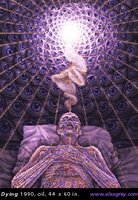 Recent voluntary euthanasia hullabaloos such as the Terry Schiavo case have revealed a public that’s largely divided and somewhat confused as to what death is and when it should actually be declared. This issue is set to get increased attention as a) more people vie for increased control over their right to die, b) our medical sensibilities migrate increasingly toward a neurological understanding of what it means to be ‘alive’ in a meaningful sense, and c) the realization that the potential for cryonics and other advanced neural rescue operations will give rise to an information theoretic interpretation as to when death should truly be declared.
Recent voluntary euthanasia hullabaloos such as the Terry Schiavo case have revealed a public that’s largely divided and somewhat confused as to what death is and when it should actually be declared. This issue is set to get increased attention as a) more people vie for increased control over their right to die, b) our medical sensibilities migrate increasingly toward a neurological understanding of what it means to be ‘alive’ in a meaningful sense, and c) the realization that the potential for cryonics and other advanced neural rescue operations will give rise to an information theoretic interpretation as to when death should truly be declared.It is customary to declare death when the heart stops beating. This only makes sense; in the past it was the practical thing to do given limited medical know how. Moreover, without ever having the phenomenon of an individual in a coma or on life support, there was no need to have an alternative conception as to when it was appropriate to declare death.
Modern technologies have twisted this practicality by introducing devices that keep people biologically alive while their brains have essentially stopped working. Individuals ‘living’ in these persistent vegetative states are a particularly macabre sight: corpses that are hooked up to machines so that the blood can keep flowing.
Of course, most people don’t quite see it that way. Many cling to the notion that life can’t possibly come to an end until the heart stops, or that some kind of ensoulment or dignity is maintained until all biological functioning ceases. In many cases, despite irrevocable damage to the brain (the word ‘persistent’ is used for good reason), many hold out for some sort of divine intervention or miraculous medical intercession.
These perspectives fail to take into account personhood-based conceptions of what it truly means to be alive. Unless one is capable of ongoing subjective engagement with the world, one is not a person. Conscious existence is a necessary condition for agency, and because the brain generates consciousness, it’s fair and reasonable to suggest that we are our brains. When a brain is damaged or malfunctioning beyond repair, then the person who owns that brain should really be considered deceased.
If, on the other hand, a cognitively impaired condition is not permanent (e.g. someone in a temporary coma) and the integrity of higher brain functioning has been maintained, a person should not be declared dead. There is still cause for hope because the fruits that can give rise to a conscious person are still intact.
This is what is referred to as an information theoretic interpretation of life and death. Functionalist and materialist conceptions of brain activity suggest that conscious individuals are the sum of their brain patterns. These patterns are expressed by tangible and measurable parts of the brain. Consequently, the ‘information’ that’s encoded in the brain and in constant flux is the person. As long as the information in the brain remains intact (i.e. the software), and provided the brain is functioning properly so that information can be computed and expressed (i.e. the hardware), a person should be considered alive – or in some cases, alive in the sense that consciousness and active personhood can be resumed at a later time.
Information theoretic death has deep implications for those interested in cryonics or the potential for mind uploading. Given the possibility for cryonic reanimation or a transferred existence into a different computational substrate, an alternative legal and medical definition of death would seem to be in order.
The argument goes as follows: If biological functioning stops for an individual, but the brain’s information can be perfectly restored and recovered at a later date, a person should not be considered permanently dead. Death, therefore, should only be declared when the information state of the brain is so disorganized that recovery is impossible.
Currently, when considering the status of an individual preserved in cryonic storage, it is not known beyond a shadow of a doubt that reanimation is impossible. In fact, with each passing year the strength of the hypothesis favouring such a possibility strengthens. Practically speaking then, cryonauts are impermanently dead as they have a non-zero potential for resuming life in the future.
Consequently, I’m in favour of an immediate change to our sensibilities as they pertain to the declaration of permanent death -- but I realize that most of society isn’t quite ready for this just yet. It will take some time before people start to acknowledge the importance of preserving the brain’s informational essence beyond biological death.
The day will come, however, when information theoretic death will become the established and legal standard for declaring a person’s permanent death. At such a time it will be information theorists rather than medical doctors who will be the ones declaring when life has truly ended.
Tags: death, information theoretic death, declaration of death, personhood, cryonics, philosophy of mind, neuroscience, mind transfer, life extension, futurism, transhumanism.

No comments:
Post a Comment